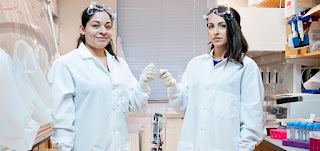The field technician, wearing an orange safety vest, a surgical mask, lab goggles, and plastic sleeves that covered his arms; stood at a sewer with two crowbars in his hands. He hooked the crowbars under the manhole cover and pushed it open. From inside he removed a bottle. He held the bottle filled with liquid to the light. It was not too cloudy. He carefully poured its contents into specimen tubes he was carrying. The tubes would be sent to a lab for analysis.
*****
Newsha Ghaeli, an Iranian who grew up in Canada, and
Mariana Matus, a Mexican, are two young women who met at MIT during their PhDs.
Mariana’s doctorate was in computational systems and systems biology, and
Newsha's in urban studies and planning. What interested them was the sewer
systems. They felt sewers were like human guts. Just as the labs can tell a lot
about an individual’s health by sampling their gut, would it be possible to
tell about the health of the community/ neighbourhood by sampling its sewage?
The two founded Biobot in 2017 to check the spread of opioid
in the community. They procured permission to take samples from the manhole
closest to their lab. They realized the manhole covers were too heavy.
Initially they would ask for help, and then move in with a 20-foot pole and a
container for scooping the sewage out. Not surprisingly, the job was not something
to look forward to. Over time, they designed a collection device with a filter
that sat inside manholes and took samples regularly in a 24-hour cycle. An
intern devised a magnetic manhole-opener. Both ladies managed to fall sick and
get rashes, so they developed meticulous protocols and PPE. By the time they
reached this stage, covid happened.
*****
Biobot was the first wastewater epidemiology team in
the USA to successfully detect the coronavirus. On 25 March, they launched a
nationwide campaign soliciting wastewater samples. They offered their analysis
free-of-cost.
As one sewer department executive said poop is a great
equalizer. In the underground gutters, whites and blacks, rich and poor,
homeless and presidents, kids and elderly are not distinguishable. This
presents several advantages for community testing. It is a large pool of people
that allows measuring where the virus is, and whether it is increasing or
decreasing. Aggregate testing is of course anonymous, and can give early
warnings to the public health department.
Over the last few months, Biobot analysis found that
infected individuals shed the covid-19 virus in their stool, regardless of
whether they have symptoms. Moreover, infected individuals shed most frequently
immediately after contracting covid, and start shedding a week before the
symptoms.
Individual patient testing, on the other hand, gives
results for only those who test. Asymptomatic patients may never test (but they
still shed the virus when infected). By the time the results are available, it
may be too late to do anything about them.
The wastewater surveillance, by tracking a community
regularly, can warn much in advance. Schools can be shut or reopened. The level
of restrictions can be modified.
*****
This community gut analysis was used in the past by
epidemiologists to track polio. But Biobot has taken this obscure practice to
another level. Their reports (see a sample) track genome copies per liter of sewage.
Already 400 cities in the USA are using their services. Biobot’s sewage
tracking currently covers 13% of US and 6% of the Canadian population.
With the danger of recurring diseases and epidemics,
this underground source to track them may become universally important.
Ravi

Wow! Who knew?
ReplyDeleteकाहीही करावं लागतंय
ReplyDelete